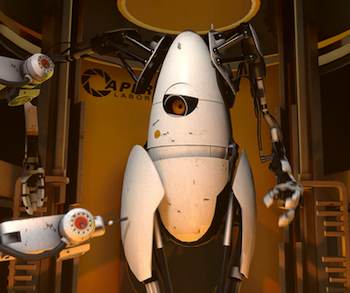- MENU
- HOME
- SEARCH
- WORLD
- MAIN
- AFRICA
- ASIA
- BALKANS
- EUROPE
- LATIN AMERICA
- MIDDLE EAST
- United Kingdom
- United States
- Argentina
- Australia
- Austria
- Benelux
- Brazil
- Canada
- China
- France
- Germany
- Greece
- Hungary
- India
- Indonesia
- Ireland
- Israel
- Italy
- Japan
- Korea
- Mexico
- New Zealand
- Pakistan
- Philippines
- Poland
- Russia
- South Africa
- Spain
- Taiwan
- Turkey
- USA
- BUSINESS
- WEALTH
- STOCKS
- TECH
- HEALTH
- LIFESTYLE
- ENTERTAINMENT
- SPORTS
- RSS
- iHaveNet.com
Chase Slaton

"Portal 2" is a fine game and its nonviolent, challenging and addictive gameplay should appeal to everyone
"Portal 2" is the sequel to Valve's 2007 hit "Portal" included as part of The Orange Box bundle -- which I'm fairly sure most people initially purchased for either "Team Fortress 2" or "Half-Life 2: Episode 2."
"Portal" was a pleasant little puzzle game that placed players in the fall cushioning springy shoes of
By firing the Portal Gun at walls, players could create physical portals between distant points which acted as physics-defying wormholes. The momentum of objects passing remained as they passed through portals, allowing
The game was somewhat short, though it included Advanced Chambers. These challenging maps could be played apart from the game's main campaign and they helped flesh out the gameplay some. The game performed well, selling around four million copies before it went up for sale on Steam. "Portal's" story ended with
"Portal 2" has
While fun, it was also unfortunately short. "Portal 2" fixes that by providing a much-longer experience. The single player campaign takes
"Portal 2" also introduces Cave Johnson, the eccentric billionaire, science advocate and founder of Aperture Science. With a personality that's a cross between Steven Colbert and Dr. Benton Quest (the dad in "Jonny Quest") Cave's interaction with
Like GLaDOS, most of Cave's lines are both disturbing and hilarious, with many of them either displaying Cave's utter lack of scientific understanding, or telling the tragic story of Aperture's rise and fall. While the writing is great, what really brings Cave to life and makes the long dead inventor a winner is the voice of J. K. Simmons. While you may remember J. K. Simmons from shows like "Law & Order" and "Oz," he also played J. Jonah Jameson in the "Spider-Man" movies. Early rumors had Cave actually replacing GLaDOS as "Portal 2's" main omnipresent voice in charge of egging
Normally, I hate co-op gameplay. Aside from a few exceptions, I normally see any sort of multiplayer mode as a waste of precious developer resources that would have been better spent on either refining the core game, or providing more single player levels. However, "Portal 2" is one of those rare cases where I have to admit that I was wrong. In addition to the single player campaign, "Portal 2" also comes with a rather addictive co-op mode that places players in control of Atlas and P-body, a pair of robot test subjects.
Rather than have players fighting each other deathmatch style, "Portal 2's" co-op mode makes players work together to complete some of the hardest puzzles in the game. Part of what makes these rooms so damned difficult to complete is the fact that even with voice chat turned on (which is built into the game) it's nearly impossible to describe the solution to a complex physics puzzle to another person without the aid of a dry-erase board.
To ease this burden, the developers provided players with incredibly handy flags. With the tap of a button, you can mark spots in the game world, or set count down timers. These allow you to, once completely frustrated with your friend's utter idiocy and failure to understand what you mean by "place one portal on the widdershins side of the rotating platform and then shoot that hanging thing as you fall," simply mark the spots where you think the portals should go. I was disappointed that I could not choose which robot I got to play as (its random each time you start a co-op game), but I was thrilled by the fact that the game saves your progress every time you complete a room. That way, rather than being forced to replay through all five co-op courses every time, you can quickly log on and play a room or two with a friend after you get home from work before life's other demands require your attention.
There has been a bit of fan anger regarding the co-op mode, though. By completing certain achievements, players can unlock hats, skins, and flags with which to adorn their little robot avatars, much like in "Team Fortress 2." What has honked some gamers off is that these embellishments are ridiculously expensive with the entire set costing
At
"Portal 2" is a fine game and its nonviolent, challenging and addictive gameplay should appeal to the majority of gamers. There's currently not a demo, but for 10 bucks you can probably pick up a copy of "Portal" from somewhere and that would essentially serve the same purpose while providing you with a great game at the same time. That aside, my advice is that if you haven't already, you should go out and buy it.